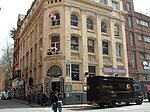Consulate of the United States, Liverpool
Buildings and structures in LiverpoolDiplomatic missions in the United KingdomDiplomatic missions of the United StatesUnited Kingdom–United States relationsUse American English from February 2019 ... and 1 more
Use mdy dates from February 2019

The United States Consulate in Liverpool, England, was established in 1790, and was the first overseas consulate founded by the then fledgling United States of America. Liverpool was at the time an important center for transatlantic commerce and a vital trading partner for the former Thirteen Colonies. Among those who served the United States as consul in Liverpool were the writer Nathaniel Hawthorne, the spy Thomas Haines Dudley, and John S. Service, who was driven out of the United States Foreign Service by McCarthyite persecution. After World War II, as Liverpool declined in importance as an international port, the consulate was eventually closed down.
Excerpt from the Wikipedia article Consulate of the United States, Liverpool (License: CC BY-SA 3.0, Authors, Images).Consulate of the United States, Liverpool
College Lane, Liverpool Ropewalks
Geographical coordinates (GPS) Address Nearby Places Show on map
Geographical coordinates (GPS)
| Latitude | Longitude |
|---|---|
| N 53.404 ° | E -2.986 ° |
Address
Poolbridge House
College Lane
L1 3BN Liverpool, Ropewalks
England, United Kingdom
Open on Google Maps









